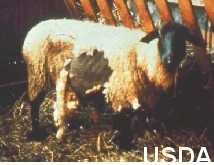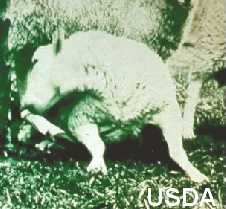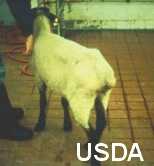Scrapie in Sheep
Introduction

Scrapie is a fatal brain disease affecting sheep and goats. It has been present in British sheep flocks for over 200 years and was first recorded in 1732. Scrapie has a worldwide distribution but is notably absent in Australia and New Zealand. Scrapie belongs to a family of diseases called Transmissible Spongiform Encephalopathies (TSE). Other TSE's include bovine spongiform encephalopathy (BSE) in cattle, chronic wasting disease (CWD) in elk and deer, and Creutzfeldt-Jacob disease (CJD) and new variant CJD in humans.
The cause of the disease is not completely understood, but it is believed to be an infectious agent called a "prion" (pree-on) which is an abnormally folded variant of a normal protein. Currently, there is no treatment or vaccine available. Any animals suspected of having scrapie must be reported to the Canadian Food Inspection Agency.
How do I know if my animals have scrapie?

Irritation
- repeated rubbing of flanks and hindquarters against objects, such as fences or posts
- repeated scratching of the flanks
- nibbling or grinding teeth when rubbing themselves or when rubbed firmly on the back
- continued scratching of the shoulder or ear with a hind foot
- unusual nibbling of the feet, legs or other parts of the body
- excessive wool loss or skin damage
Changes in behaviour (from normal)
- becoming excitable
- drooping ears
- increased nervousness
- lagging behind
- aggression
- depression or vacant stare
Changes in posture and movement
- trembling
- unusual high stepping trot, hopping like a rabbit or swaying back end
- loss of coordination
- stumbling
- standing awkwardly
- weak hind legs
- unable to stand
Later signs
- weight loss
- death
Animals with scrapie may appear normal, while left undisturbed at rest. However, when stimulated or startled the animal may tremble or appear to have a seizure.
What else could these signs indicate?

Scrapie affected sheep are almost always thin. Other problems that may cause signs similar to scrapie in sheep include; ovine progressive pneumonia, listeriosis, rabies, external parasites (lice and mites), pregnancy toxemia and toxins.
When does scrapie occur?
Age
Most cases of scrapie occur in sheep between two and five years of age. However, age alone cannot be used to rule out the presence of scrapie because in rare instances it does occur outside this timeframe.
Numbers affected
Cases of scrapie generally appear singly because symptoms of the disease appear a long time after initial infection. This is very different from diseases such as Foot and Mouth Disease or contagious abortion, which can spread quickly through a flock.
Season
Cases can occur at any time of the year, but stress can cause the symptoms to appear. Therefore, scrapie may be more obvious at certain times, such as when sheep are brought in for lambing.
Development of signs
Scrapie takes a long time to develop and during this time there may be no signs of the disease. The signs may not start to appear until months or even years after infection. They usually develop gradually, although in some cases an animal's condition may deteriorate quickly. After the onset of clinical signs sheep may live 1 to 6 months or longer, but death is inevitable.
Transmission
Scrapie is spread through fluid and tissue from the placentas of infected sheep. It can be passed from a female sheep to her lambs when they are born or to other lambs born in the same area. A sheep's genes may affect its susceptibility to the disease and the length of the incubation period. Rams can get scrapie but they do not transmit the disease to other animals.
Diagnosis
The only way to determine if an animal has scrapie is to examine the brain tissue under a microscope after death. Blood testing can be done to check the genetic profile of the animal, allowing farmers to screen their sheep for susceptibility to the disease and current research is directed at early diagnosis by biopsy of lymphoid tissue from the tonsil or the eyelid. There is no guarantee that even a genetically resistant animal won't develop scrapie, because it is an infectious disease.
Genetics
Scrapie is caused by an abnormality in the prion protein and changes in this prion protein gene may determine whether an animal is likely to develop the disease when exposed to it. This gives the possibility of breeding for resistance to scrapie in a sheep flock, although resistance may actually be just a delay in the onset of the disease. Research has suggested that some genetic lines of sheep are far more susceptible to the disease manifestations of scrapie than are other genetic strains of sheep. At the present time further research is needed to fully establish the genetic factors associated with scrapie.
National Control Program
Scrapie is a reportable disease under the federal Health of Animals Act, so any suspected cases must be reported to the Canadian Food Inspection Agency (CFIA). Infected or exposed sheep are humanely destroyed and carcasses are burned or buried by the producer and may be supervised by the CFIA.
Implementation of the national control program in a flock may be different dependant on the risk associated with transmission. If two or more animals from different bloodlines in a flock are diagnosed with scrapie, usually the whole flock is destroyed. At minimum, if only one animal is diagnosed all of its offspring and any other lambs born in the same area where it gave birth, are destroyed. If there are no records the whole flock will be at increased risk of depopulation.
Owners are compensated up to a maximum of $600 per head for animals that are required to be destroyed. This value is based on the commercial value of the animal, as agreed upon by the CFIA and the producer. The CFIA regulations call for appointment of a valuation committee chaired by an employee of the CFIA. The owner of the animal to be destroyed has the right to representation on the committee. Compensation is not paid for loss of business, clean up and disinfection or for maintenance of stock between the time of diagnosis and disposal. CFIA pays compensation for the costs related to the disposal of the animals, including the cost to lease equipment to dig a landfill site and the costs of incineration. The owner must submit receipts for eligible costs to the district veterinarian for reimbursement by the CFIA.
What can I do to prevent my animals from contracting scrapie?
The Canadian Food Inspection Agency recommends the following:
- report suspected cases to local district vet of CFIA (listed in government pages of the Manitoba phonebook)
- individual identification for each animal in the flock
- keep track of all lambings and the location where each lamb was born
- record identity of all sheep sold and the names and addresses of purchasers
- keep full records on the source of all sheep purchased
- before buying an animal make sure that the farm it comes from has had no cases of scrapie in the past 60 months
- separate sick animals from healthy ones
- examine promptly by a veterinarian if they do not respond to routine treatments
- have veterinarian examine an animal that dies of an unknown cause
- have sick animals give birth in separate area and remove and bury placenta
- if possible, put all sheep in individual pens when they are lambing
- practice good hygiene when handling all lambs and dispose of placentas immediately
- use separate needles for vaccinations and injections
- disinfect equipment used for tail docking, debudding or castration, between animals by soaking equipment in a mixture of three parts water to one part commercially available bleach.
If scrapie is suspected in the flock, producers should consult with their veterinarian or the CFIA directly.
Scrapie research
Currently, work is on developing a live-animal test to diagnose infected sheep before they show signs. A promising new test using a biopsy of the third eye-lid of the apparently healthy animal has been developed in the USA. Researchers are also investigating the transmissibility of the scrapie agent, identifying the scrapie agent and its different strains, identifying the genes that influence scrapie infection and examining the role that artificial insemination and embryo transfer may play.
For further information, contact your local Veterinarian, Manitoba Agriculture and Food Livestock Specialist or the Canadian Food Inspection Agency.
Canadian Food Inspection Agency offices:
Regional Office - (204) 983-7441
Boissevain - (204) 534-6288
Brandon - (204) 726-7556
Carman - (204) 745-2292
Dauphin - (204) 638-3322
Minnedosa/Shoal Lake - (204) 867-3241
Portage La Prairie - (204) 857-4171
Winnipeg - (204) 983-2219
This fact sheet was prepared by:
Heather Froebe
Manitoba Sheep Industry Initiative (administered by the Manitoba Sheep Association Inc. in cooperation with Manitoba Agriculture and Food)
Funding for this fact sheet was provided by:



